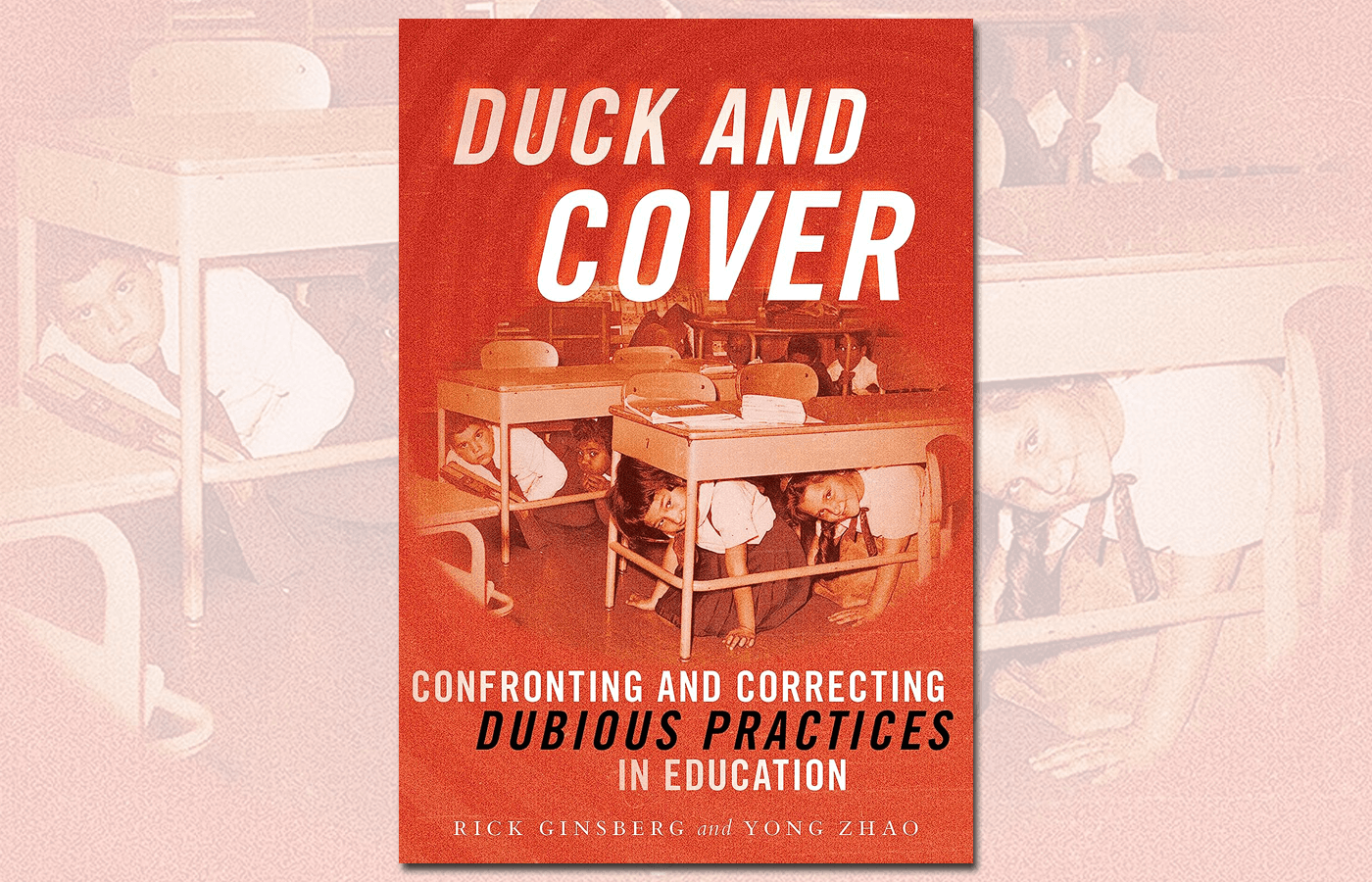
Rick Ginsberg and Yong Zhao are out with an intriguing new book, Duck and Cover: Confronting and Correcting Dubious Practices in Education. The title refers to the mantra of 1950s-era school drills, back when a nation living under the threat of nuclear holocaust taught its children to “duck and cover” in the event of a Soviet attack.
As the authors explain in their introduction, “The practice was simple. If there was imminent fear of a bomb hitting a school or landing in its vicinity, students were trained to dive under their desks and cover their heads with their hands.” The implication, of course, was that kneeling under their desk would protect students from a nuclear blast. Spoiler: It wouldn’t. But the Federal Civil Defense Program produced the 1951 film “Duck and Cover,” anyway, in which Bert the cartoon turtle cheerfully taught a generation to “duck and cover.”
As Ginsberg and Zhao drolly observe, “This has to be one of the most stupid educational policies ever enacted.” Why did so many policymakers and educators go along with a policy that terrified young students while doing nothing to protect them? Ginsberg and Zhao argue that policymakers and educators felt obliged to do something—and, if something stupid was the only option, well, they’d do that. They offer this as a metaphor for many foolish, ineffectual policies in American schooling.
I’m a fan of both authors. Ginsberg is dean of education at the University of Kansas, former board chair of the American Association of Colleges of Teacher Education, a savvy observer of school reform, and an old friend. Zhao is a distinguished professor at Kansas and a refugee from communist China, whose contempt for bureaucracy and quasi-authoritarian meddling has made him one of the nation’s more heterodox education thinkers.
In the course of the book’s brisk 156 pages, Ginsberg and Zhao skewer a lot of sacred cows. The 19 chapters cover the educational waterfront: social-emotional learning (SEL), educational technology, college and career readiness, class size, dress codes, professional development, teacher evaluation, gifted education, testing, school board governance, and much more.
The breadth of topics hints at both the strengths and the weaknesses of this volume. Its great strength is its evenhanded willingness to say critical things about a lot of popular ideas. Readers of every ilk can rest assured that they’ll find some things to delight them and others that infuriate them. In our polarized world, this marks a welcome departure from the familiar groupthink. The authors deserve kudos for that alone.
Their approach also allows them to cover a lot of ground, making a number of provocative observations and offering a number of useful cautions. But the trade-off is that they don’t spend a lot of time or energy making the case that a given idea is stupid. Most of the chapters didn’t offer parallels to “duck and cover” or so much as thumbnail sketches of the good, bad, and ugly of how these ideas work in practice.
Thus, when it comes to SEL, Ginsberg and Zhao note the pressure school leaders face from “experts and researchers, do-gooders, and sometimes snake-oil salespersons shopping their wares.” They then sketch the rationale for SEL and a number of concerns about it, before offering some sensible advice about the need to move deliberately and clarify goals. This is all fine. But none of it really makes the case that SEL is a “dubious practice” (and I say this as someone who’s been plenty skeptical of SEL). As a reader, given the promise of the book’s subtitle, central metaphor, and setup, this felt like less than I bargained for. This is pretty consistent throughout.
And I would’ve liked to see them push harder when explaining how dubious ideas catch on and why we can be so reluctant to confront them. After all, I’ve explored the frenzied pace of school reform and why some reforms might appeal more than others. Given that, I hoped for more than the broad reminder that “schools actually implement a lot of different things” and the observation that “duck-and-cover policies persist because they aren’t questioned.” At the outset, the book promises a bold exploration of folly; on this count, it delivers something less than that.
Ultimately, though, this is a timely and valuable contribution. Ginsberg and Zhao have penned a fair-minded survey of education policy, with a healthy emphasis on the need to think more deliberately about how things actually work. And that’s a worthwhile exercise and a much-needed reminder, one that educators, policymakers, and advocates should take to heart.
Frederick Hess is director of education policy studies at the American Enterprise Institute and an executive editor of Education Next.
This post originally appeared on Rick Hess Straight Up.


